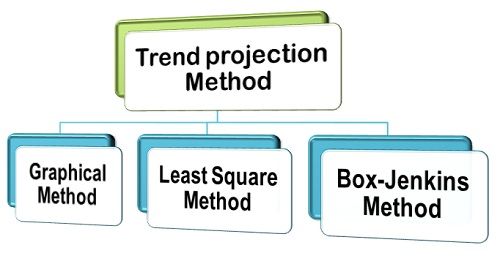Definition: The Trend Projection Method is the most classical method of business forecasting, which is concerned with the movement of variables through time. This method requires a long time-series data.
The trend projection method is based on the assumption that the factors liable for the past trends in the variables to be projected shall continue to play their role in the future in the same manner and to the same extent as they did in the past while determining the variable’s magnitude and direction.
In predicting demand for a product, the trend projection method is applied to the long time-series data. A long-standing firm can obtain such data from its departments (such as sales) and the books of accounts. While the new firms can obtain data from the old firms operating in the same industry. The trend projection method includes three techniques based on the time-series data. These are:
- Graphical Method: It is the most simple statistical method in which the annual sales data are plotted on a graph, and a line is drawn through these plotted points. A free hand line is drawn in such a way that the distance between points and the line is the minimum. Under this method, it is assumed that future sales will assume the same trend as followed by the past sales records. Although the graphical method is simple and inexpensive, it is not considered to be reliable. This is because the extension of the trend line may involve subjectivity and personal bias of the researcher.
- Fitting Trend Equation or Least Square Method: The least square method is a formal technique in which the trend-line is fitted in the time-series using the statistical data to determine the trend of demand. The form of trend equation that can be fitted to the time-series data can be determined either by plotting the sales data or trying different forms of the equation that best fits the data. Once the data is plotted, it shows several trends. The most common types of trend equations are:
- Linear Trend: when the time-series data reveals a rising or a linear trend in sales, the following straight line equation is fitted:
S = a + bT
Where S = annual sales; T = time (years); a and b are constants. - Exponential Trend: The exponential trend is used when the data reveal that the total sales have increased over the past years either at an increasing rate or at a constant rate per unit time.
- Box-Jenkins Method: Box-Jenkins method is yet another forecasting method used for short-term predictions and projections. This method is often used with stationary time-series sales data. A stationary time-series data is the one which does not reveal a long term trend. In other words, Box-Jenkins method is used when the time-series data reveal monthly or seasonal variations that reappear with some degree of regularity.
Thus, these are the commonly used trend-projection methods that tell about the trend of demand for a product and are based on a long and reliable time-series data.


Rahul shekhaliya says
Thank you
This information is very helpful and verry nice
Thanks for help
Jyothsnareddy says
This information is very easy
vikramjeet says
yeah really